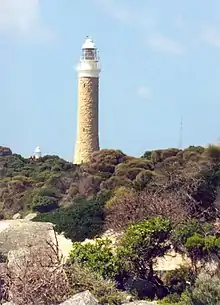Eddystone Point
Eddystone Point lies on the north-east coast of Tasmania, Australia at 40.994 S/148.349 E.

History
The first European to sight Eddystone Point was the Dutch navigator, Abel Tasman. In December 1642, Tasman sailed along the entire east coast of Van Diemen's Land (Tasmania).[1] He recorded that he tried to follow the coast around this headland, but he could not penetrate the wind wall.[2] The howling westerly gale indicated that here was a strait, not a bay, so Tasman resumed his easterly course to continue his continent-hunting.[3]
The next European visitor was Tobias Furneaux in HMS Adventure during James Cook's second Pacific voyage, which took place during the period of intense Anglo-French rivalry that filled the twelve years between the Seven Years' War and the American Revolutionary War. In March 1773, Furneaux retraced Tasman's course up the east coast of the island to discover whether or not it was joined to New Holland. At 2 a.m. on 19 March, his ship was suddenly tossed 40 miles out to sea and lost its sails. Furneaux named the headland Eddystone Point, after the notorious Eddystone Rocks in the English Channel.[4]
Seal hunting took place here from at least 1827.[5]
Six applications were made to the colonial government to lease land for whaling stations at Eddystone Point in 1841.[6] It is uncertain how many of these leases were taken up.
Eddystone Point Lighthouse
In 1884, the adjacent colonies of Tasmania and Victoria were discussing the erection of a lighthouse at Eddystone Point, which was eventually built[7] in 1889. The lighthouse and keepers' cottages are made of granite, quarried from nearby.[8] Head of works and head mason was James Galloway from Glasgow, Scotland, who migrated to Tasmania to oversee the building program. His brother, Alexander Galloway, also migrated from Glasgow to work on the building of the lighthouse and cottages.
In the early 1920s, heavy storms damaged the buildings, jetties and equipment, and flooded the tower.[8]
In 1935, wireless communication was installed.[8]
In 1960, the First Order Chance Brothers lens that had been removed from the Cape du Couedic Lighthouse on Kangaroo Island in South Australia was shipped to Melbourne for installation at Eddystone Point Lighthouse.[9]
References
- Schilder, Günter (1976). Australia unveiled : the share of the Dutch navigators in the discovery of Australia. Amsterdam: Theatrum Orbis Terrarum Ltd. p. 170. ISBN 9022199975.
- Valentyn, Francois (1724–1726). Oud en nieuw Oost-Indien. Dordrecht: J. van Braam. p. vol.3, p.47. ISBN 9789051942347.
- Cameron-Ash, M. (2018). Lying for the Admiralty: Captain Cook's Endeavour Voyage. Rosenberg. pp. 105–106. ISBN 9780648043966.
- Cameron-Ash, M. (2018). Lying for the Admiralty. Sydney: Rosenberg. pp. 155–159. ISBN 9780648043966.
- Kostoglou, Parry (1996). Sealing in Tasmania historical research project (First ed.). Hobart: Parks and Wildlife Service. p. 76.
- Evans, Kathyrn (1993). Shore-based whaling in Tasmania historical research project; Volume 2; site histories (First ed.). Hobart: Parks and Wildlife Service. p. 66.
- "Eddystone Lighthouse". The Mercury. Hobart, Tasmania. 5 December 1884. p. 3. Retrieved 3 July 2011 – via National Library of Australia.
- "Eddystone Point Lighthouse". Lighthouses of Australia Inc. Retrieved 1 September 2021.
- "Cape du Couedic" (Interactive map + text.). Australian Maritime Safety Authority. 2020. Retrieved 1 September 2021.
 Text may have been copied from this source, which is available under a Attribution 4.0 International (CC BY 4.0) licence. (See copyright notice.
Text may have been copied from this source, which is available under a Attribution 4.0 International (CC BY 4.0) licence. (See copyright notice.
External links
 Media related to Eddystone Point Lighthouse at Wikimedia Commons
Media related to Eddystone Point Lighthouse at Wikimedia Commons- John Smeaton A narrative of the building and a description of the construction of the Edystone Lighthouse (1791 and 1793 editions) – Linda Hall Library